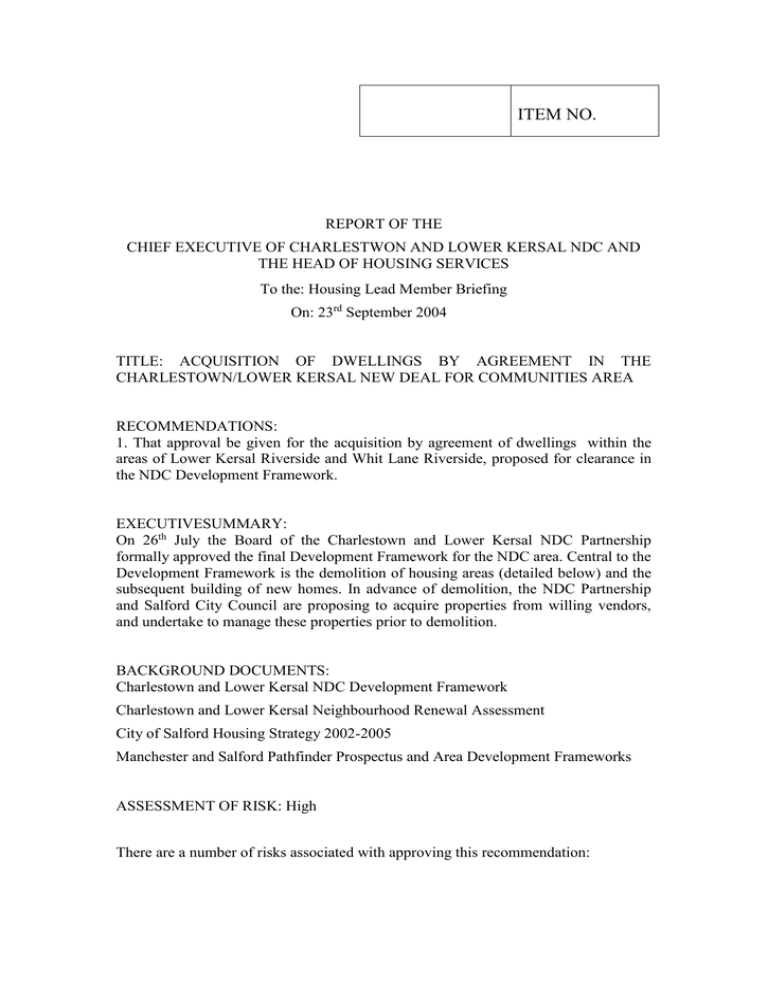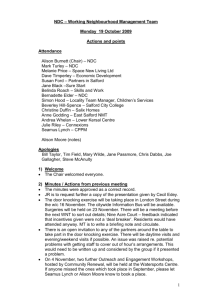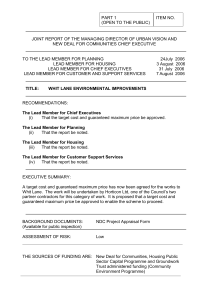ITEM NO.
advertisement

ITEM NO. REPORT OF THE CHIEF EXECUTIVE OF CHARLESTWON AND LOWER KERSAL NDC AND THE HEAD OF HOUSING SERVICES To the: Housing Lead Member Briefing On: 23rd September 2004 TITLE: ACQUISITION OF DWELLINGS BY AGREEMENT IN THE CHARLESTOWN/LOWER KERSAL NEW DEAL FOR COMMUNITIES AREA RECOMMENDATIONS: 1. That approval be given for the acquisition by agreement of dwellings within the areas of Lower Kersal Riverside and Whit Lane Riverside, proposed for clearance in the NDC Development Framework. EXECUTIVESUMMARY: On 26th July the Board of the Charlestown and Lower Kersal NDC Partnership formally approved the final Development Framework for the NDC area. Central to the Development Framework is the demolition of housing areas (detailed below) and the subsequent building of new homes. In advance of demolition, the NDC Partnership and Salford City Council are proposing to acquire properties from willing vendors, and undertake to manage these properties prior to demolition. BACKGROUND DOCUMENTS: Charlestown and Lower Kersal NDC Development Framework Charlestown and Lower Kersal Neighbourhood Renewal Assessment City of Salford Housing Strategy 2002-2005 Manchester and Salford Pathfinder Prospectus and Area Development Frameworks ASSESSMENT OF RISK: High There are a number of risks associated with approving this recommendation: The housing market could rise further, meaning that the cost of acquiring the properties increases above the level estimated; If future acquisition of properties were not possible the Council may be left with a number of vacant properties to manage; An assumption has been made around the level of private sector investment in the scheme in future years, and it is impossible to guarantee that this level of funding can be realised. If a smaller amount of investment is achieved, it will be necessary to look for alternative sources of funding; An assumption has been made around the level of HMRF funding that may be available in 2006/07. If this allocation is not realised, it will be necessary to look for alternative sources of funding; An assumption has been made around the level of Salford City Council funding that may be available across all years, but the available level of funding is unknown at this stage. If this funding is not available for this scheme it will be necessary to look for alternative sources of funding; The flood protection issues associated with the proposed development sites are still under investigation and until these issues are resolved there is a risk that they may adversely affect potential development. There is also a risk associated with not approving this recommendation as it will be difficult to achieve the transformational change that is required in this area, as set out by the ODPM. THE SOURCE OF FUNDING IS: The total current estimated cost of acquiring and demolishing all the privately owned residential properties indicated by the NDC Development Framework, together with the relocation of two businesses and payment of disturbance payments to relocate NPHL tenants is £16,135,500. A provision of £1,295,500, drawn from a range of funding, has been made within the capital programme for the current financial year. This is funded by HMRF £1,052,500 and NDC Physical Programme £243,000. This would leave a balance of some £15,000,000 to be accommodated in the capital programmes of future years, in line with available resources and priorities. This will be via a combination of HMRF, NDC and possibly City Council resources. Consideration is already being given to the HMRF programme for 2005/06 where these figures are being built in to formulate an indicative programme for next year. At the same time the prospectus for the next three years is also being developed for HMRF where the commitments arising from current decisions are being built in together with matched funding. Therefore the precise build up of the funding can not be accurately given at this point in time, especially given that the amount of Council resources to support the whole Housing Capital Programme is not known, plus there will be other priorities for these resources. However, a proposed profile is attached which shows how the potential funding may be provided. There must the flexibility for these costs to be spread over future years to maximise grants and minimise the call on limited Council resources. This profile indicates that the level of funding that is expected to be required from HMRF and Salford City Council may be at least matched by the level of private investment, with NDC investment in addition. The NDC has now commissioned consultants to advise and support the process of appointing a developer partner, which is expected to be in Spring 2005. By agreeing to this voluntary acquisition programme, the Council is not legally making a forward commitment year on year. However, if it becomes necessary to undertake Compulsory Purchase Order proceedings in order to secure the acquisition of properties, this would represent a legal commitment to the Council and would be the subject of a further report. LEGAL ADVICE OBTAINED: Ian Sheard FINANCIAL ADVICE OBTAINED: Nigel Dickens CONTACT OFFICER: Brian Enright/Catherine Fox WARD(S) TO WHICH REPORT RELATES: Kersal and Irwell Riverside KEY COUNCIL POLICIES: City of Salford Housing Strategy 2002-2005 DETAILS: NDC Development Framework Charlestown and Lower Kersal NDC Partnership has been charged with the regeneration of the area. To this end it commissioned BDP consultants to draw up a Development Framework that would guide development in the area over the next seven years. This document was presented to the Board on 15th December 2003 where it was approved as a basis for consultation. Following this, a “Visioning” document was produced and put out to consultation between 25th January and 5th March 2004. The results of this consultation were then presented to the Board on 5th April 2004 and subsequently on 17th May 2004. Finally, the Board approved the final Development Framework on 26th July 2004 and Cabinet endorsed the Development Framework in principle on September 1st 2004. The NDC’s Development Framework identifies a number of housing development sites. The major development sites identified are at Whit Lane Riverside and Kersal Riverside. To support the development of these sites, areas of housing clearance have also been proposed. For both sites the inclusion of proposed housing has been carefully assessed with regard to the planning issues re development, HMRF objectives and consideration of feedback from consultation with residents within proposed clearance areas. These areas – Whit Lane Riverside and Lower Kersal Riverside - are described below (see also attached plans). A total of 357 properties are proposed for demolition within the areas. Whit Lane Riverside The Whit Lane Riverside development proposes two significant areas of clearance. Auckland Drive/Britannia Street, which is predominantly public sector with some ‘right to buys’ and the area of mainly private terraced housing including the north side of Levens Street, Thursfield Street, Reading Street, Chinley Street and Wainman Street, as well as properties fronting onto Littleton Road In total this area comprises 291 properties of which, there are 9 Right To Buys and 185 Private properties It comprises of the Whit Lane estate, The area for proposed for clearance between Britannia/Auckland Street has been included to support the remodelling of the existing poor urban structure (including provision of community facilities/open space) and to maximise the potential for riverside development. This latter element is seen as a key driver in ensuring a mix of new quality housing that in turn meets the HMRF objective of widening the choice and availability of housing types in local housing markets, thus ensuring sustainability in the local housing market. The inclusion of the proposed clearance area of terraced housing between Levens Street to Reading Street is closely related to the objectives of HMRF. The local private housing market is dominated by Victorian/Edwardian terraced properties. Since the inception of NDC vacancy rates have risen in landlord properties from 7% in 2001 to 13% in 2004. Reducing the numbers of terraced properties will support sustainability of the remaining older stock in line with HMRF objectives. In addition, the clearance of this area of property will open a second gateway into the Whit Lane River supporting the redevelopment of the area and enabling the transformational change of the local environment/housing market that is part of the HMRF ADF vision. Lower Kersal Riverside The Kersal Riverside development site proposes an area of clearance of mainly public sector housing including Northallerton Road, Sherwood Avenue, Rushley Avenue, Winster Avenue and part of Kingsley Avenue. There are also owner occupied houses at 109 and 111 South Radford Street. In total this area comprises 66 properties of which, there are 9 Right To Buys. The inclusion of these properties is seen as strategic to the development of the land along the Irwell, which is adjacent to the properties. At present there is poor access to the river and vacant land and a poor vista along to the frontage of the site. This development will provide the opportunity to create a better relationship with the river and provide the potential to develop the site for quality housing. Again these proposals meet the fundamental objectives of HMRF by diversifying the housing stock and transforming the environment of the local housing market. HMRF Area Development Framework The Central Salford Area Development Framework (ADF) is an integrated strategy that seeks to fundamentally transform neighbourhoods and re-structure the housing market. Importantly, one of the ADF’s key interventions is that of site assembly. The NDC Development Framework provides detailed guidance that allows for this site assembly in advance of demolition and the re-development of targeted sites. Acquisition Process Since the launch of the Development Framework on January 25th, a number of residents and landlords have approached the Partnership indicating that they would be willing to sell their property or properties. It is proposed, therefore, that the Council’s Property Services Section be given authority to enter into negotiations with owners of properties within the areas defined above with a view to acquiring their properties by agreement. All such acquisitions would be made on the basis of a deemed Compulsory Purchase Order, with both Home Loss and Disturbance Payments being paid where applicable. It should be noted that the acquisition of dwellings on this basis is in line with established Council policy and current guidance on best practise. It will also strengthen the Council’s case at any eventual CPO inquiry, if it can demonstrate that it had made all reasonable attempts to negotiate with a given owner to purchase their property before resorting to the use of CPO powers. Management of Acquired Properties It is proposed that the following strategy for managing acquired properties be implemented. Once a property is purchased, its condition would be assessed. If the property was deemed to be in a poor condition it would be secured. The method of securing each property will be determined in terms of risk of vandalism and the likelihood of breakin. For example, if the property has a high risk attached to it, it will be “sheeted up” (most likely with polycarbonate material) Alternatively, if the property is deemed low risk, it could simply have curtains fitted to give it an appearance of being occupied. Housing Options for Residents Affected by Demolition The NDC Physical Team is currently working with colleagues in the Housing Market Renewal Team, affected residents and other stakeholders to draw up a set of housing options that will be available to residents affected by demolition. The options developed through this process will be guided by the City Council’s established policy of making all reasonable efforts to ensure that affected residents should not be disadvantaged by clearance activity. Options to be looked at under this process will include choices for owner-occupiers aimed at enabling them to access either a new property when development takes place, or, allow them to purchase a property not affected by demolition. However for a number of property owners, for example absentee owners, the preferred solution will be to sell as soon as possible, at open market value, in such cases it is in the Council’s interest to acquire in order to ensure proper management and deter speculation. Conclusion The acquisition of properties in those areas proposed for demolition in the NDC area, is key to the delivery of both the Development Framework and the Central Salford Area Development Framework. Obtaining approval to begin this process is of paramount importance. C:\Documents and Settings\execbenright\Desktop\ExecutiveSummary2-2004730-4015634-533.doc

